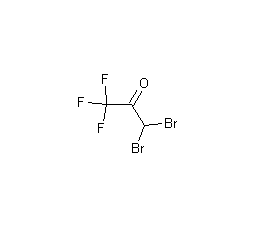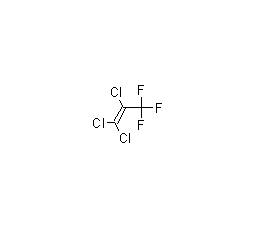1,1-dibromo-3,3,3-trifluoroacetone


Structural formula
| Business number | 04T2 |
|---|---|
| Molecular formula | C3HBr2F3O |
| Molecular weight | 269.85 |
| label |
1,1-dibromo-3,3,3-trifluoroacetone, 1,1-DIBROMO-3,3,3-TRIFLUOROACETONE, 3,3-DIBROMO-1,1,1-TRIFLUOROACETONE, 1,1-Dibromo-3,3,3-trifluoroacetone 97%, 1,1-Dibromo-3,3,3-trifluoroacetone97%, 3,3-Dibromo-1,1,1-trifluoropropan-2-one |
Numbering system
CAS number:431-67-4
MDL number:MFCD00041362
EINECS number:None
RTECS number:None
BRN number:636645
PubChem ID:None
Physical property data
一 , physical property data
Traits :Light red liquid
Density (g/mL,25/4℃): Not available
Relative Vapor density (g/mL, air=1):Not available
Melting point (ºC): Not available
Boiling point (ºC, normal pressure): 111
Boiling point (ºC, 5.2kPa): Not available
Refraction Rate: Not available
Flash Point (ºC): Not available
Optical rotation (º): Not available
Spontaneous combustion Point or ignition temperature (ºC): Not available
Steam Pressure (kPa, 25ºC): Not available
saturated Vapor pressure (kPa, 60ºC): Not available
Burn Heat (KJ/mol):Not available
Critical Temperature (ºC): Not available
Critical Pressure (KPa): Not available
oil and water Log value of the (octanol/water) partition coefficient:Not available
Explosion Upper limit (%, V/V): Not available
Explosion Lower limit (%, V/V): Not available
Dissolve Properties: Not available
Toxicological data
Two , Toxicological data:
Acute Toxicity:Not available .
Ecological data
Three , Ecological data:
1 , Other harmful effects: This substance may be harmful to the environment, and special treatment should be given to water bodies. Notice.
Molecular structure data
1、 Molar refractive index:31.85
2、 Molar volume(m3/mol):118.3
3 , Isotonic specific volume (90.2K):281.8
4、 Surface tension(dyne/cm):32.2
5、 Polarizability(10-24cm3):12.62
Compute chemical data
1. Reference value for hydrophobic parameter calculation (XlogP): 2.7
2. Number of hydrogen bond donors: 0
3. Number of hydrogen bond acceptors: 4
4. Number of rotatable chemical bonds: 1
5. Number of tautomers: 2
6. Topological molecule polar surface area 17.1
7. Number of heavy atoms: 9
8. Surface charge: 0
9. Complexity: 119
10. Number of isotope atoms: 0
11. Determine the number of atomic stereocenters: 0
12. Uncertain number of atomic stereocenters: 0
13. Determine the number of chemical bond stereocenters: 0
14. Number of uncertain chemical bond stereocenters: 0
15. Number of covalent bond units: 1
Properties and stability
None yet
Storage method
None yet
Synthesis method
None yet
Purpose
None yet








